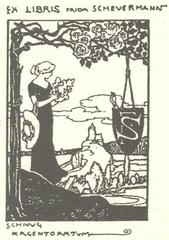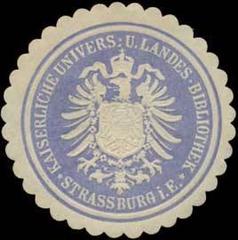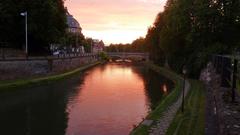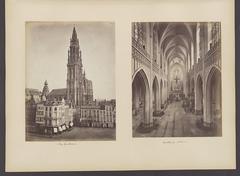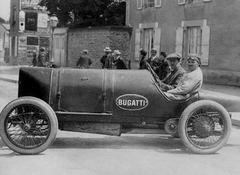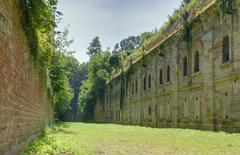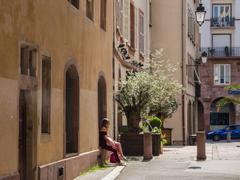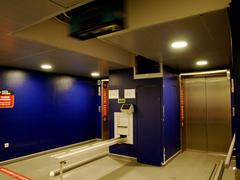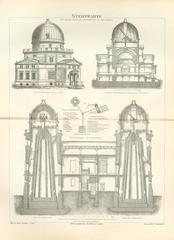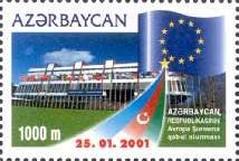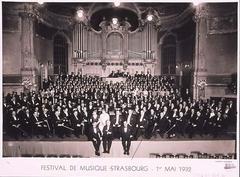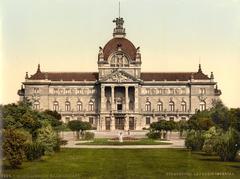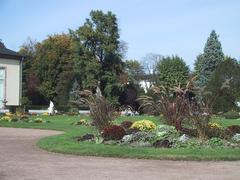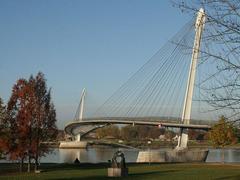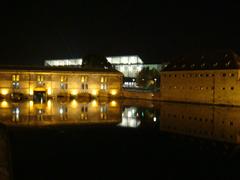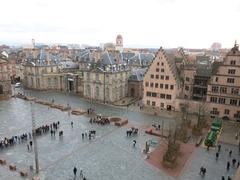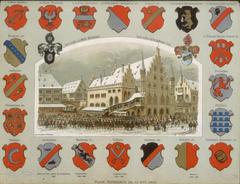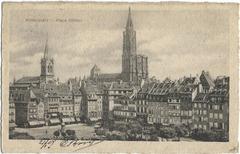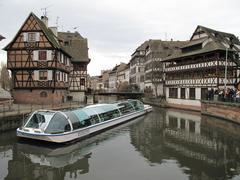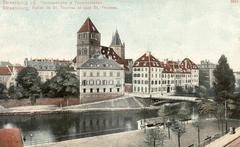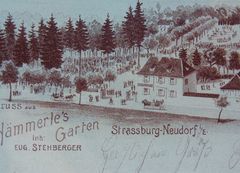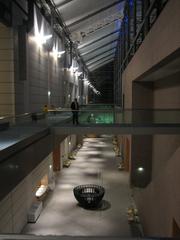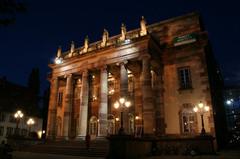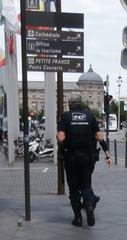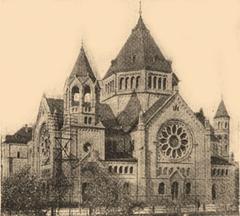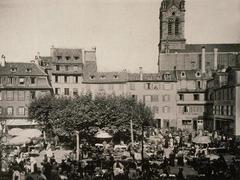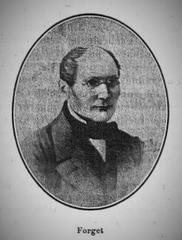
Lycée Fustel-De-Coulanges Strasbourg: Visiting Hours, Tickets, and Historical Significance
Date: 04/07/2025
Introduction
Located in the heart of Strasbourg’s UNESCO-listed Grande Île, the Lycée Fustel-De-Coulanges is more than an active educational institution—it is a living monument, deeply intertwined with the city’s layered history and architectural heritage. Its origins date back to the late 17th century, evolving from a Jesuit Collège Royal established after the French annexation of Strasbourg in 1681. Today, its classical façades proudly face Place du Château, near Strasbourg Cathedral and Palais Rohan, forming a key part of the city’s historical and cultural landscape (Lycée Fustel-De-Coulanges official site, Monumentum, Strasbourg Tourism Office).
While the lycée mainly serves as an active school, opportunities to visit arise during special cultural events such as the European Heritage Days, when guided tours open its doors to the public. This guide details the institution’s historical evolution, architectural highlights, visitor information, accessibility, and nearby attractions, assisting travelers in planning a rewarding experience in Strasbourg.
Historical Overview
Origins and Foundation (1681–1804)
The Lycée’s beginnings trace back to the establishment of the Collège Royal by the Jesuits in 1685, following King Louis XIV’s annexation. The college’s aim was to educate Alsatian youth in Catholicism and the French language, with its original Baroque-classical buildings still forming the core of today’s complex.
Napoleonic Era and Institutional Development (1804–1870)
In 1804, the school became an official lycée under Napoleon, serving as Strasbourg’s principal boys’ secondary institution throughout the 19th century. The lycée’s evolution reflected the city’s political transitions, shifting between French and German systems.
Franco-German Rivalry and Change (1871–1918)
After the Franco-Prussian War, the school was renamed Kaiserliches Lyzeum under German administration, adapting to the region’s changing governance.
Modern Identity and Legacy (1919–Present)
Following World War I, the school was renamed Lycée Fustel-de-Coulanges in honor of historian Numa Denis Fustel de Coulanges, emphasizing its intellectual legacy and commitment to humanist values. During the Second World War, it functioned as Oberschule Erwin von Steinbach under Nazi occupation, before reclaiming its French identity and expanding as a center for advanced studies, notably in literary and archival disciplines.
Architectural and Heritage Significance
Monument Historique Status
The lycée’s façades and steeply pitched roofs facing Place du Château have been protected as historic monuments since 1929 (Monumentum). The exteriors showcase a harmonious blend of Baroque and classical influences, with balanced proportions, stone pilasters, and traditional Alsatian tiled roofs.
Interior Layout
While much of the interior has evolved to meet modern needs, aspects of the original Jesuit layout remain, including the central courtyard and select historic spaces. The building’s orientation complements nearby landmarks, creating a dialogue between secular and religious architecture in the city’s core.
Cultural Significance and Community Role
Academic Excellence and Legacy
Lycée Fustel-De-Coulanges is renowned for its rigorous curriculum and intellectual tradition, producing distinguished alumni such as Jules Ferry, an architect of modern French education (JDS). The institution’s enduring humanist ethos continues to influence Strasbourg’s educational landscape.
Civic Engagement
The lycée frequently serves as a hub for civic discourse and social movements, demonstrated by recent student-led demonstrations in support of international causes, reflecting its ongoing role in shaping engaged citizens (DNA).
Visiting Information
Opening Hours
The lycée operates as an educational institution and is not open for general public visits. However, guided tours are organized during special events, chiefly European Heritage Days in September. These tours typically run from 10:00 AM to 6:00 PM; confirm dates on the official website or Strasbourg Tourism Office.
Tickets and Entry
Admission is free during heritage events. Advance registration may be required for guided tours due to limited capacity.
Accessibility
Historic architecture limits full accessibility inside, but the exterior and surrounding public spaces are accessible. Visitors with reduced mobility are encouraged to contact organizers in advance for assistance.
Travel Tips
- The lycée is at 1 Place du Château, facing Strasbourg Cathedral.
- Reachable by tram (stops: “Langstross/Grand’Rue”, “Porte de l’Hôpital”, “Broglie”) and bus.
- Limited car access due to pedestrian zones; parking is available at Parking Gutenberg or Parking Austerlitz.
Nearby Attractions
- Strasbourg Cathedral: A masterpiece of Gothic architecture just steps away.
- Palais Rohan: Historic palace with major museums.
- La Petite France: Picturesque canals and half-timbered houses.
- Place Kléber: Strasbourg’s lively central square.
Combine your visit to the lycée with these iconic sites for a full Strasbourg experience.
Accommodation and Amenities
While the lycée does not offer on-site lodging, several student residences and hostels are nearby, including Foyer de l’Étudiant Catholique (FEC), Foyer Jean Sturm, Amitel Residences, and Maison de l’Étudiante. Advance booking is recommended.
Nearby, visitors will find a range of cafés, restaurants, and boutiques, as well as public spaces perfect for relaxation and photography.
Frequently Asked Questions (FAQ)
Q: Can I visit the interior of the Lycée Fustel-De-Coulanges?
A: Interior access is restricted to students and staff, except during special events such as European Heritage Days.
Q: Are guided tours available?
A: Guided tours are offered during cultural events; check the official website for details.
Q: Is there an entry fee?
A: Admission is free during open events; some tours may require advance booking.
Q: Is the site accessible for people with disabilities?
A: Exterior areas are accessible; interior access may be limited.
Q: Is photography allowed?
A: Exterior photography is permitted; consult event organizers for interior photography guidelines.
Plan Your Visit and Stay Updated
For current visiting opportunities, events, or guided tours, consult the official Lycée website or Strasbourg Tourism Office. For alumni and heritage news, join the Amicale des anciens élèves. Download the Audiala app for interactive tours and cultural updates.
Summary
Lycée Fustel-De-Coulanges epitomizes Strasbourg’s fusion of educational tradition, architectural grandeur, and civic vitality. Its strategic location and storied legacy make it a focal point for heritage tourism and urban exploration. While public access is primarily during special events, these occasions offer an excellent opportunity to appreciate one of Strasbourg’s most treasured historical sites. Plan your visit around these events, and take advantage of nearby attractions to fully experience the city’s rich heritage.
Sources and Further Reading
- Lycée Fustel-De-Coulanges official site
- Monumentum
- Strasbourg Tourism Office
- Amicale des anciens élèves
- JDS
- DNA



